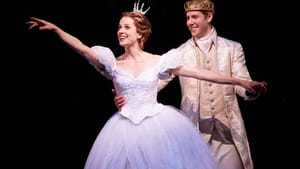Stay in the Loop
BSR publishes on a weekly schedule, with an email newsletter every Wednesday and Thursday morning. There’s no paywall, and subscribing is always free.
A 21st-century fairy tale
Rodgers & Hammerstein’s 'Cinderella'

You have to admire the guts of the people who reworked this old classic. They made major changes in the story and significant additions to the score. I’ve never seen such a well-liked show altered to this extent.
When you take a TV production or movie and put it on stage, extra songs are helpful to fill out the greater playing time. That was done when Cinderella was performed at the London Coliseum in 1958 and subsequently in some U.S. theaters. But this production, which made its Broadway debut in 2013, goes far beyond. It adds characters, subtracts others, creates new story lines and eliminates the Prince’s familiar kingdom-wide search for a girl who can fit into the glass slipper.
I normally dislike the changing of show titles to promote the creators (as The Gershwins’ Porgy and Bess or Rodgers & Hammerstein’s Oklahoma!); it’s unnecessary and unwieldy. Here’s an exception. Attendees should be informed that this is neither Disney’s sugary Cinderella nor the original dark story by Charles Perrault.
Version 3.0
Actually, this should be called Rodgers & Hammerstein’s Cinderella 3.0 because the script and song list are so markedly different from the previous R&H versions. (The original was a live television production starring Julie Andrews in 1957).
The Prince’s parents have been excised; now he’s an orphan under the thumb of a villainous Lord Chancellor. A newly-invented Crazy Marie is a woman who lives in the forest and reemerges as the Fairy Godmother. Also new is Jean-Michel, a young revolutionary who rallies the townsfolk to protest the government’s policy “to take away people’s homes,” whatever that may mean.
In this production, Prince Christopher is continually referred to as Topher. At the ball where he meets Cinderella, instead of being beguiled by her beauty, the prince falls for Ella because of her forthright exposure of his government’s policies and her advocacy of reforms.
In another departure, one of Cinderella’s stepsisters realizes that Ella was the mysterious woman at the palace dance and pledges to help by giving her a nice dress in which to attend a second ball. At this ball, Cinderella intentionally leaves her slipper behind so Topher will be impelled to chase after her.
Mixed message, mixed results
This reimagined Cinderella works imperfectly. The political agenda is forced, and the adults who appreciate that angle are likely to recoil at the silly sight of the prince fighting dragons and gargoyles. Topher’s battle scenes and byplay among the stepsisters are clearly aimed at the children in the audience. Adolescent girls who have flocked to see Wicked surely will respond to the dreamlike portions of this show, which is in the beginning phase of a national tour.
The additions to the music are excellent. When the Prince fears that he’ll never again see Cinderella, he sings the gorgeous "Loneliness of Evening," which Rodgers and Hammerstein wrote for Lieutenant Cable to sing in South Pacific, then cut before opening night. Cinderella is given a ballad, "There’s Music in You," written for a 1953 R&H film, Main Street to Broadway, with Mary Martin and Agnes Moorehead. That song gets a triumphant reprise during the wedding scene at the end of this Cinderella. “Now Is the Time,” cut from South Pacific, is given to Jean-Michel. A tune cut from Me and Juliet, "Me, Who Am I?" is used to introduce the prince, and there are other supplements from the R&H trunk.
The lilting “Do I Love You Because You’re Beautiful?,” “Ten Minutes Ago,” “A Lovely Night,” and “Impossible” are happily retained from the original production. When the focus is on the score and on romance, this production is at its best.
The leads are ideal. Paige Faure stepped into the role of Ella three months into the show’s Broadway run, and she is an appealing singer and dancer — a superstar on the ascendency. Andy Jones is the eager and boyish Prince. Kecia Lewis is a powerful belter as the Fairy Godmother, while David Andino is appropriately nerdy as the leftist firebrand.
This go-round has more dancing than in the show’s television productions, and Josh Rhodes’s choreography gives it energetic shape.
What, When, Where
Rodgers & Hammerstein’s Cinderella. Music by Richard Rodgers, lyrics by Oscar Hammerstein II, new book by Douglas Carter Beane. Mark Brokaw directed. November 25-30, 2014 at the Academy of Music, Broad and Locust Streets, Philadelphia. 215-893-1999 or www.kimmelcenter.org.
Sign up for our newsletter
All of the week's new articles, all in one place. Sign up for the free weekly BSR newsletters, and don't miss a conversation.

 Steve Cohen
Steve Cohen